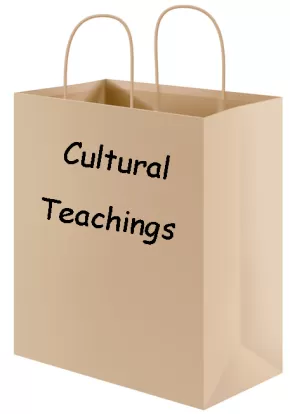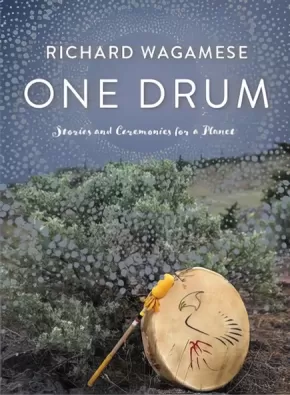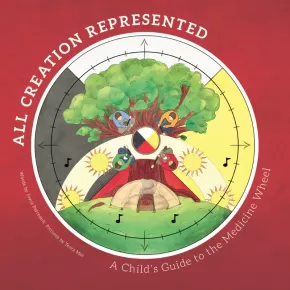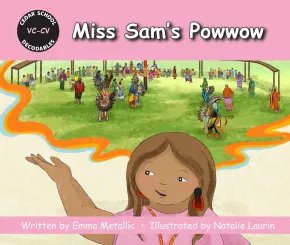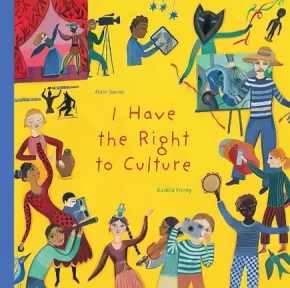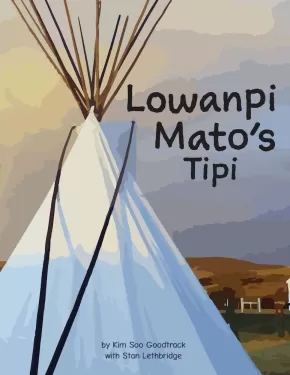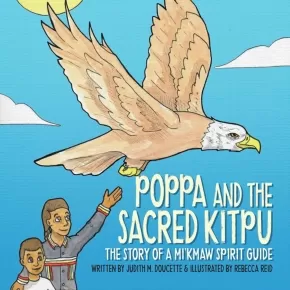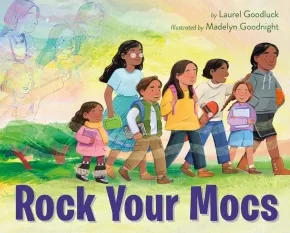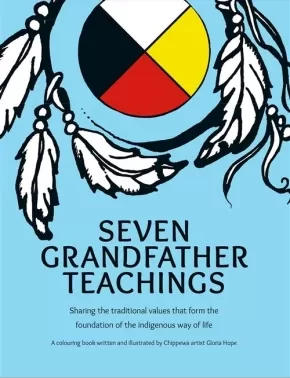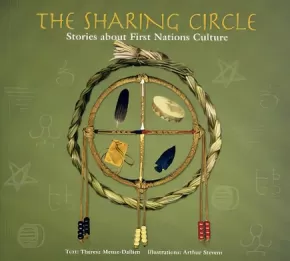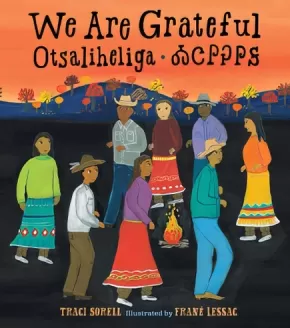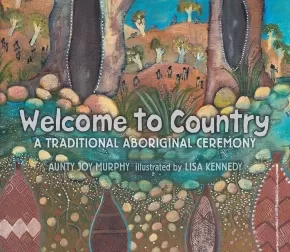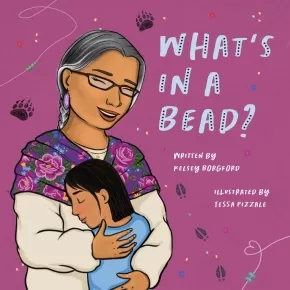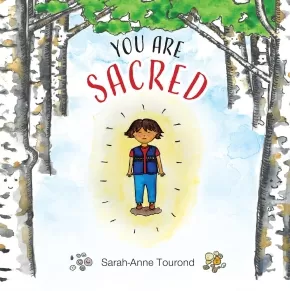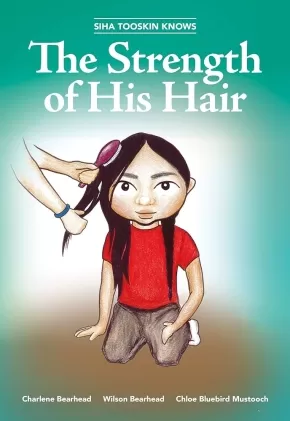
Learn at Home-Homeschool Theme Bundle: Cultural Teachings
$443.18
Text Content Territories:
Indigenous American; Native American; Indigenous Canadian; First Nations; Métis;
Status: Available
Details:
This Learn at Home/Homeschool Theme Bundle includes resources for learning about different cultural teachings and cultural diversity. Indigenous and non-Indigenous resources are included.
Educator Information
Included in our Learn at Home/Homeschool Theme Bundles are fiction and nonfiction titles. Some may be independent reads, others are read alouds, and some provide parent/caregiver support or are an interactive title full of activities. As well, some of the bundles contain a puppet, game, or other learning resources.
Scroll below to learn more about each resource included. Resource availability may fluctuate.
● The listed materials for this bundle
can be purchased as a full bundle or separately. To purchase the full bundle click on the "Add to
Basket" button above (the first one on this page).
● To purchase items individually, click the "Add to Basket" buttons below, beneath the individual
item titles.
Parent Resource
One Drum: Stories and Ceremonies for a Planet
$21.95
Format:
Paperback
Text Content Territories:
Indigenous Canadian; First Nations; Anishinaabeg; Ojibway; Wabaseemoong First Nation;
Grade Levels: 12; University/College;
ISBN / Barcode: 9781771622295
Synopsis:
Synopsis:
“The most profound truth in the universe is this: that we are all one drum and we need each other.” —Richard Wagamese, One Drum
A posthumous volume of stories and ceremonies -- and a fitting tribute to Richard Wagamese's spiritual and literacy legacy.
Fans of Richard Wagamese’s writing will be heartened by the news that the bestselling author left behind a manuscript he’d been working on until shortly before his death in 2017. One Drum welcomes readers to unite in ceremony to heal themselves and bring harmony to their lives and communities.
In One Drum, Wagamese wrote, “I am not a shaman. Nor am I an elder, a pipe carrier, or a celebrated traditionalist. I am merely one who has trudged the same path many of this human family has—the path of the seeker, called forward by a yearning I have not always understood.”
One Drum draws from the foundational teachings of Ojibway tradition, the Grandfather Teachings. Focusing specifically on the lessons of humility, respect and courage, the volume contains simple ceremonies that anyone anywhere can do, alone or in a group, to foster harmony and connection. Wagamese believed that there is a shaman in each of us, and we are all teachers and in the world of the spirit there is no right way or wrong way.
Writing of neglect, abuse and loss of identity, Wagamese recalled living on the street, going to jail, drinking too much, feeling rootless and afraid, and then the feeling of hope he gained from connecting with the spiritual ways of his people. He expressed the belief that ceremony has the power to unify and to heal for people of all backgrounds. “When that happens,” he wrote, “we truly become one song and one drum beating together in a common purpose—and we are on the path to being healed.”
Additional Information
160 pages | 5.50" x 8.00"
Resources for Children (Picture Books, Fiction, and Nonfiction)
A Dance Through the Seasons
$20.95
Artists:
Format:
Paperback
Text Content Territories:
Indigenous Canadian; First Nations; Dene; Dakelh (Carrier);
ISBN / Barcode: 9781777894740
Synopsis:
Synopsis:
Young Woman, like many people her age, is full of curiosity, energy and strength. What happens when people around you don’t recognize that strength?
This story is about the journey of Young Woman and Turtle. They move through the seasons together and Young Woman learns that growing up takes patience and time. Leadership comes from within, but it also comes from listening to the world around you.
A Dance Through the Seasons not only leads you through the story of one girl’s path, but also through the seasonal rounds of the Dakelh (Carrier) people of British Columbia.
Educator Information
The inspiring A Dance Through the Seasons is told through story and cultural teachings by award-winning Dakelh educator Leona Prince, with dream-like illustrations from acclaimed Cree and Métis artist Carla Joseph.
Readers of all ages will admire Young Woman as she endures and learns from each of the four seasons using many traditional means. Like Young Woman, we all have something to learn – from nature, the seasons, and our Elders, when we recognize and trust in our guides.
Find all of the hidden turtles in each illustration as they guide you through her journey.
This is the second edition.
This book is available in French: Une Danse au Fil des Saisons.
Additional Information
56 pages | 11.00" x 8.50" | Paperback | 2nd Edition
All Creation Represented: A Child's Guide to the Medicine Wheel
$16.95
Artists:
Format:
Paperback
Text Content Territories:
Indigenous Canadian; First Nations; Anishinaabeg; Ojibway;
ISBN / Barcode: 9780995012714
Synopsis:
Synopsis:
All Creation Represented is a child’s guide to the Medicine Wheel. Told from an authentic perspective of an Anishinaabe / Ojibwe knowledge holder, Joyce Perreault skillfully weaves together traditional teachings with modern educational goals, making this book an excellent resource for children of all ages.
The Medicine Wheel is a foundation of teaching and learning that shows how different parts of life are connected and balanced. Many generations of Indigenous cultures have understood the world through Medicine Wheel teachings. The Medicine Wheel offers holistic and relational ways of understanding the self, the family, the community, the natural and spiritual world. The book introduces the concept of a Medicine Wheel, highlighting the significance of the associated ancestral teachings as it discusses various aspects of human well-being, the physical world, and Indigenous culture. This book is designed as an education resource and embodies First Peoples Principles of Learning.
Learn the Ojibwe words that are represented by various aspects of the Medicine Wheel with a glossary at the back of the book, and explore a way of looking at the world that is holistic, sacred, and powerful. All Creation Represented will help readers consider the wisdom and knowledge of the First Peoples who used the Medicine Wheel to teach about and understand the world around them.
Educator Information
This book is designed as an education resource and embodies First Peoples Principles of Learning.
Additional Informaiton
32 pages | 8.25" x 8.25"
Cedar School Decodables: Miss Sam’s Powwow
 $7.99
$7.99

Artists:
Format:
Paperback
Text Content Territories:
Indigenous Canadian; First Nations; Mi'kmaq (Mi'gmaq); Listuguj Mi'gmaq First Nation;
Grade Levels: Kindergarten; 1;
ISBN / Barcode: 9781771746489
Synopsis:
Synopsis:
In this story, Miss Sam talks to the class about powwows. Miss Sam has danced at powwows since she was a child.
Mi’gmaq gather with their community to dance and sing at powwows. This is also a time for healing and prayers.
What celebrations do you go to?
Educator Information
Recommended for ages 4-7, for use in kindergarten and Grade 1 classrooms.
Cedar School Decodables is divided into six sets, which increase in word count and complexity of sentence structure. Miss Sam’s Powwow is in Set 4 – Longer Words, and reviews closed/closed syllable words and compound words. Books in Set 4 have 90-100 words.
Readers should be familiar with the concepts included in Set 1 to Set 4:
- consonants
- beginning and end blends
- short and long vowels
- digraphs
- a /o/
- s – /s/ and /z/
- -s, -es, -ed, and -ing suffixes
- VC-CV, V/CV, VC/V, and compound words
- possessives
Series Information
Welcome to Cedar School! Join Liv, Tom, Gus, and Bell as they learn on the land and explore Mi’gmaw teachings with their teacher, Miss Sam, and the school’s Mi’gmaw Elder, Jen. With charming illustrations and simple storylines, this decodable series engages students as they practise their reading skills. Each book includes a pre-reading review of non-decodable words, and many of the books introduce special words related to Indigenous teachings. Talking Together prompts facilitate discussions led by the reading teacher.
Developed in partnership with Dyslexia Canada, Cedar School Decodables is a series of 20 decodable books for young readers. Designed for students who have previously learned short vowel and consonant sounds, additional phonic skills are developed progressively throughout the series.
The series will be accompanied by Cedar School Decodables Teacher’s Guide and a series of four picture books, which will be available at a later date.
This book is included in the Indigenous Books for Schools database from the Association of Book Publishers of BC. It is recommended for K to 2 classrooms for English Language Arts and Social Studies.
Additional Information
16 pages | 6.5” x 5.5” | Paperback | ISBN: 9781771746489
Cedar School Decodables: We Smudge
 $7.99
$7.99

Artists:
Format:
Paperback
Text Content Territories:
Indigenous Canadian; First Nations; Mi'kmaq (Mi'gmaq); Listuguj Mi'gmaq First Nation;
Grade Levels: Kindergarten; 1;
ISBN / Barcode: 9781771746502
Synopsis:
Synopsis:
In this story, Gus and Tom are upset. Miss Sam helps them smudge to feel better.
Mi’gmaq burn sage and other traditional medicines to smudge. Smudging helps people let go of sadness and anger.
What do you do when you are feeling sad?
Educator Information
Recommended for ages 4-7, for use in kindergarten and Grade 1 classrooms.
Cedar School Decodables is divided into six sets, which increase in word count and complexity of sentence structure. We Smudge is in Set 5 – Ending Spelling Patterns, and reviews -tch and -dge. Books in Set 5 have 100-110 words.
Readers should be familiar with the concepts included in Set 1 to Set 5:
- consonants
- beginning and end blends
- short and long vowels
- digraphs
- suffixes and ending spelling patterns
- a /o/
- s – /s/ and /z/
- VC-CV, V/CV, VC/V, and compound words
This book is included in the Indigenous Books for Schools database from the Association of Book Publishers of BC. It is recommended for K to 1 classrooms for English Language Arts and Social Studies.
Series Information
Welcome to Cedar School! Join Liv, Tom, Gus, and Bell as they learn on the land and explore Mi’gmaw teachings with their teacher, Miss Sam, and the school’s Mi’gmaw Elder, Jen. With charming illustrations and simple storylines, this decodable series engages students as they practise their reading skills. Each book includes a pre-reading review of non-decodable words, and many of the books introduce special words related to Indigenous teachings. Talking Together prompts facilitate discussions led by the reading teacher.
Developed in partnership with Dyslexia Canada, Cedar School Decodables is a series of 20 decodable books for young readers. Designed for students who have previously learned short vowel and consonant sounds, additional phonic skills are developed progressively throughout the series.
The series will be accompanied by Cedar School Decodables Teacher’s Guide and a series of four picture books, which will be available at a later date.
Additional Information
16 pages | 6.5” x 5.5” | Paperback | ISBN: 9781771746502
Celebrating Potlatches
$21.95
Artists:
Format:
Hardcover
Text Content Territories:
Indigenous Canadian; First Nations; Tsimshian (Ts'msyen); Nisga'a;
ISBN / Barcode: 9781771746564
Synopsis:
Synopsis:
“Papa, what is a Potlatch?”
Inspired by Ts’msyen Chief William Beynon’s historic notebooks on Potlatches in the Gitxsan village of Gitsegukla, Celebrating Potlatches pairs intergenerational storytelling with beautiful illustrations to honour Indigenous traditions. From the award-winning author of Oolichan Moon and the accomplished illustrator of Be a Good Ancestor, this book recounts the 1885 Potlatch ban and the resilience of the communities who fought to keep their traditions alive.
Awards
- CCBC's Best Books for Kids & Teens, Fall 2025
Reviews
“Heartfelt and timely, Celebrating Potlatches gifts readers with cultural teachings through an intergenerational account of Indigenous resilience. This book is a beautiful tribute to the author’s great-grandfather, William Beynon, whose life’s work documenting oral histories of Sm’algya̱x-speaking Peoples and their Potlatches continues to be foundational to our cultural resurgence today.” – Sm Łoodm ‘Nüüsm (Dr. Mique’l Dangeli), Sm’algya̱x language expert and Assistant Professor of Indigenous Arts at the University of Victoria
“This beautiful book shares the importance of community, culture, and identity. As you make your way through the pictures and words, they bring you to an understanding of how important the Potlatch ceremony was and continues to be for Indigenous Peoples.” – Carolyn Roberts, educator, speaker, and author of Re-Storying Education
Educator Information
Recommended for ages 4 to 8.
Through this conversational historic account, readers can learn alongside the narrator as his Papa shares his wisdom about the rich history of the Potlatch.
Curriculum Connections
- Early literacy – listening, reading, and discussing
- Art – traditional Indigenous art, drumming, and regalia
- Social studies – the 1885 Potlatch ban, history of Indigenous Peoples, connection to community
- Social responsibility – uplifting ourselves and others, honouring traditions
- Indigenous knowledge and traditions – traditional teachings, Potlatch ceremonies, intergenerational storytelling
Two free, downloadable lesson plans—one for kindergarten to Grade 1 and one for Grades 2 to 3—provide connections to Social Studies curriculum.
Additional Information
32 Pages | 10" x 8.5" | Hardcover
Dancing With Our Ancestors
$21.95
Artists:
Format:
Hardcover
Text Content Territories:
Indigenous Canadian; First Nations; Tlingit; Haida; Tsimshian (Ts'msysen); Indigenous American; Alaska Native; Tsimshian; Tlingit; Haida;
ISBN / Barcode: 9781774920244
Synopsis:
Synopsis:
Learn about the cultural significance of the Haida potlatch through the sights, sounds, and dances of this once-banned ceremony.
In this tender picture book, Sara Florence Davidson transports readers to the excitement of a potlatch in Hydaburg, Alaska—her last memory of dancing with her late brother.
It feels like my brother and I have always known how to sing the songs and dance the dances of our Haida ancestors. Unlike our father, we were born after the laws that banned our cultural practices were changed. The potlatch ban did not exist during our time, so we grew up dancing and singing side by side.
The invitations have been sent. The food has been prepared. The decorations have been hung. And now the day of the potlatch has finally arrived! Guests from all over come to witness this bittersweet but joyful celebration of Haida culture and community.
Written by the creators of Potlatch as Pedagogy, this book brings the Sk'ad'a Principles to life through the art of Janine Gibbons.
Educator & Series Information
Recommended for ages 6 to 8.
This book is part of the Sk'ad'a Stories series.
Additional Information
40 pages | 8.12" x 9.00" | Hardcover
I Have the Right to Culture
$19.99
Artists:
Format:
Hardcover
ISBN / Barcode: 9781773064901
Synopsis:
Synopsis:
From the author and illustrator duo who created the award-winning I Have the Right to Be a Child and I Have the Right to Save My Planet comes this beautifully illustrated third book in the series.
I Have the Right to Culture explores a child’s right to be curious and to experience all of humanity’s shared knowledge, including music, art, dance and much more. When a child is born, they learn the language of their parents, they sing the songs of their grandparents and they eat the delicious food that their family prepares. They also start to wonder about the lives of other children who live far away. What languages do they speak? What songs do they sing? And what games do they play?
Every child has the right to learn about the world they live in, including its history and its inventions. Every child has the right to learn about artists, about writers, about potters and photographers and architects, about musicians and dancers and poets. All of humanity’s treasures are for sharing, and every child has the right to know about what has come before them! Children have the right to partake in culture as proclaimed in the United Nations Convention on the Rights of the Child.
Told from the perspective of a child, this colorful and vibrant book explores what it means to be a child who has the right to find beauty in their world.
Educator & Series Information
Recommended for ages 3 to 6.
This book is part of the I Have the Right series.
Correlates to the Common Core State Standards in English Language Arts:
CCSS.ELA-LITERACY.RI.K.1
With prompting and support, ask and answer questions about key details in a text.
CCSS.ELA-LITERACY.RI.K.6
Name the author and illustrator of a text and define the role of each in presenting the ideas or information in a text.
CCSS.ELA-LITERACY.RI.K.7
With prompting and support, describe the relationship between illustrations and the text in which they appear (e.g., what person, place, thing, or idea in the text an illustration depicts).
CCSS.ELA-LITERACY.RI.1.8
Identify the reasons an author gives to support points in a text.
Additional Information
48 pages | 10.00" x 10.00" | Hardcover
Lowanpi Mato’s Tipi
 $18.50
$18.50

Artists:
Format:
Hardcover
Text Content Territories:
Indigenous Canadian; First Nations; Sioux; Lakota;
ISBN / Barcode: 9781771744751
Synopsis:
Synopsis:
“Hokahe! Welcome!”
Welcome to Wood Mountain, home of the Lakota People, in southern Saskatchewan. It is here that we meet Stan Lethbridge, whose ancestral name is Lowanpi Mato (Singing Bear).
Join Lowanpi Mato as he prepares to set up his summer Tipi. He shares with us Lakota life values and traditions, and how they connect to building and taking care of a Tipi. He teaches us that to build a Tipi you need many items; some are from natural sources and others are purchased from a store. Lowanpi Mato takes us through a step-by-step building process so that we can all learn how a Tipi is built.
The Lakota language is woven throughout the story. The Lakota counting chart on pages 30 and 31 invites you to learn to count and have some fun looking back through the book to find items that match each number.
Welcome to Wood Mountain, home of the Lakota People, in southern Saskatchewan. It is here that we meet Stan Lethbridge, whose ancestral name is Lowanpi Mato (Singing Bear).
Join Lowanpi Mato as he prepares to set up his summer Tipi. He shares with us Lakota life values and traditions, and how they connect to building and taking care of a Tipi. He teaches us that to build a Tipi you need many items; some are from natural sources and others are purchased from a store. Lowanpi Mato takes us through a step-by-step building process so that we can all learn how a Tipi is built.
The Lakota language is woven throughout the story. The Lakota counting chart on pages 30 and 31 invites you to learn to count and have some fun looking back through the book to find items that match each number.
Educator Information
Lakota language is woven throughout this story, as are the seven values of Lakota life.
Lakota language is woven throughout this story, as are the seven values of Lakota life.
Includes a counting chart from 1 to 20 in Lakota, as well as a search-and-find counting game.
Additional Information
32 pages | 8.5" x 11" | Hardcover | ISBN: 9781771744751
32 pages | 8.5" x 11" | Hardcover | ISBN: 9781771744751
Making a Whole Person: Traditional Inuit Education
$22.95
Artists:
Format:
Hardcover
Text Content Territories:
Indigenous Canadian; Inuit;
ISBN / Barcode: 9781774502051
Synopsis:
Synopsis:
“Before schools were introduced to the Inuit, we were taught by our relatives.”
In this picture book, Monica Ittusardjuat shares how she learned knowledge and skills in a time before being taken to residential school. She describes how children learned through playing games, imitating grown-ups, and observing adults around them.
Educator & Series Information
Recommended for ages 7 to 9.
Inhabit Education Books is proud to introduce Qinuisaarniq (“resiliency”), a program created to educate Nunavummiut about the history and impacts of residential schools, policies of assimilation, and other colonial acts that affected the Canadian Arctic. This book is a part of that program.
Each resource in the program has been carefully written and reviewed to include level-appropriate opportunities for students to learn about colonial acts and policies that affected Inuit. Topics covered include the residential school system, relocations to settlements and the High Arctic, sled dog slaughters, the use of E and W numbers, and others. These acts and policies created long-lasting impacts on Inuit individuals and communities, which are still being felt today.
The resources in this program include personal interviews, testimony, and writing; non-fiction informational resources; and information about traditional Inuit practices.
This resource is included in the Canadian Indigenous Books for Schools 2020/2021 list as being useful for grades 2 to 4 for English Language Arts and Social Studies.
Additional Information
26 pages | 8.00" x 9.00"
Poppa and the Sacred Kitpu
$18.95
Artists:
Format:
Paperback
Text Content Territories:
Indigenous Canadian; First Nations; Mi'kmaq;
ISBN / Barcode: 9781774571859
Synopsis:
Synopsis:
After being invited into his grandson’s school to share his wisdom and knowledge of his traditional Mi’kmaw culture in Poppa and His Drum, Poppa is happy to return as a respected Indigenous Elder and Knowledge Keeper.
In this second book of the Poppa series, we find Poppa giving his next gin’masuti (lesson in our culture) to his grandson, François, and his friends, Paul and Joe.
The boys have an important art project to complete for school and are not sure what to do. While spending the afternoon on a beach adventure with Poppa, the boys get to learn about the Sacred Kitpu (Bald Eagle) and why it’s so important to our Indigenous People.
Poppa engages the children with eager imaginations of how the Sacred Kitpu is not only a powerful spirit guide, but also represents the Spirit of the Creator among us. It is the messenger between Mother Earth and the Spirit World, whispering to the Creator our prayers, touching the face of the Creator with its wing.
Poppa teaches the children through mystic wonder how we use the Sacred Kitpu feather in many different cultural ceremonies. He embraces their eagerness to learn and shares the tradition of smudging, using the Kitpu feather along with Sacred Medicines that burn in a smudge bowl to purify our body, mind, and spirit.
The children delight in discovering Poppa’s never-spoken-of regalia treasures that once belonged to his grandfather and decide to commemorate their art project to the Sacred Kitpu.
Poppa is invited back to the class to award the winning medal to the winners of the arts project. He is proud to present the medals to happy children who truly understand and appreciate the importance of the role the Sacred Kitpu plays in our Mi’kmaw culture and heritage. Poppa and the Sacred Kitpu will delight and surprise the reader with fun and teachings given by the love of a Poppa who is cherished by his community for being such a wonderful Mi’kmaw Elder.
Educator & Series Information
Recommended for ages 5 to 12.
This book is the second book in the Poppa series, following Poppa and His Drum.
Additional Information
9.00" x 9.00" | Paperback
Relatives With Roots
$17.50
Artists:
Format:
Paperback
Text Content Territories:
Indigenous Canadian; Métis;
ISBN / Barcode: 9781926795003
Synopsis:
Synopsis:
Relatives With Roots: A Story About Métis Women’s Connection to the Land is a heartfelt story about a Métis grandmother who takes her granddaughter out into the bush to teach her how to pick traditional medicines. As the granddaughter learns the traditional beliefs and stories about how the Métis people use the plants for food and medicine, she feels happy to be a Métis child with access to such wonderful cultural knowledge. This charming and vibrant book introduces young readers to key concepts in the traditional Métis worldview while focusing on the special relationship between a young Métis girl and her grandmother. Relatives With Roots is the second in a series of children’s books relating to traditional Métis values by Leah Marie Dorion. The first book, The Giving Tree: A Retelling of a Traditional Métis Story, was nominated in 2010 for a Willow Award in the Shining Willow category.
Additional Information
61 Pages | 28 cm x 21.5 cm
Rock Your Mocs
$24.99
Artists:
Format:
Hardcover
Text Content Territories:
Indigenous American; Indigenous Canadian;
ISBN / Barcode: 9780063099890
Synopsis:
Synopsis:
In this happy, vibrant tribute to Rock Your Mocs Day, observed yearly on November 15, author Laurel Goodluck (Mandan, Hidatsa, and Tsimshian) and artist Madelyn Goodnight (Chickasaw) celebrate the joy and power of wearing moccasins—and the Native pride that comes with them. A perfect book for Native American Heritage Month, and all year round!
We’re stepping out
and kicking it up.
Wearing beauty on their feet—
as art, as tradition,
with style, with pride—
kids from different Native Nations know
every day is a day to ROCK YOUR MOCS!
This book contains an author’s note with additional information about moccasins and Rock Your Mocs day, for readers curious to learn more about intertribal pride and the joy found in different Native identities! Rock Your Mocs Day has now been extended to a week in November, and during that week, kids from all over the United States and North America join together to show pride in their heritage.
Educator Information
Recommended for ages 4 to 8.
Additional Information
32 pages | 10.00" x 8.00" | Hardcover
Seven Grandfather Teachings
$9.95
Artists:
Format:
Paperback
Text Content Territories:
Indigenous Canadian;
ISBN / Barcode: 9781927727041
Synopsis:
Synopsis:
The Seven Grandfather Teachings are traditional values that are respected around the world by most Indigenous peoples as universal teachings. The Seven Grandfather Teachings depict the meaning behind all that we say, do and create.
In this colouring book you will explore the seven sacred teachings and the animals that represent each one. Written and Illustrated by Chippewa artist Gloria Hope.
"I was smitten when I first saw this colouring book. Not only have colouring books come into vogue, but Gloria's art and understanding of our Sacred Teachings are uniquely amazing! To allow children the pleasure of becoming a part of the book while coming to better understand the Sacred Teachings is nothing less than brilliant." David Bouchard
Stand Like a Cedar
$21.95
Artists:
Format:
Hardcover
Text Content Territories:
Indigenous Canadian; First Nations; Salish; Interior Salish; Nlaka'pamux (Thompson); Coast Salish; Sto:lo;
ISBN / Barcode: 9781553799214
Synopsis:
Synopsis:
When you go for a walk in nature, who do you see? What do you hear?
Award-winning storyteller Nicola I. Campbell shows what it means “to stand like a cedar” on this beautiful journey of discovery through the wilderness. Learn the names of animals in the Nłe7kepmxcín or Halq’emeylem languages as well as the teachings they have for us. Experience a celebration of sustainability and connection to the land through lyrical storytelling and Carrielynn Victor’s breathtaking art in this children’s illustrated book.
Discover new sights and sounds with every read.
Reviews
"Stand Like a Cedar is a work of grace and dignity, a celebration of land, family, and knowing who you are and where you come from and being so grateful for everything you’ve been given. Bravo, Nicola Campbell and Carrielynn Victor for creating this treasure. I love it."—Richard Van Camp, author of Little You and A Blanket of Butterflies
"Campbell’s rhythmic writing is wonderful, conveying important messages about the environment and family. Victor’s vibrant renderings accompany the engaging text nicely. Bold illustrations portray elements such as weather, nature, and animals alongside evocative details like glowing skylines. An Indigenous girl shares vivid lessons in this lovely, thoughtful environmental tale." —Kirkus Reviews
"Stand Like a Cedar is a story that connects the journey of building connections through a journey in the wilderness. Through the blended use of the Nłeʔkepmxcín and Halq'emeylem languages, readers are exposed to the healing that takes place in nature. The lyrical storytelling celebrates the healing and strength that comes from building one’s connections to their own journey." - The Dalai Lama Center
Educator Information
Recommended for ages 6 to 9.
Learn the names of animals in the Nłe7kepmxcín or Halq’emeylem languages as well as the teachings they have for us.
Includes a glossary of phrases and a translation guide.
Includes a page of back matter on Coastal and Interior Salish Languages.
This book is available in French: Debout comme un grand cedre
Additional Information
40 pages | 8.12" x 7.75"
Strong Readers Set B: We Greet the Four Animals (L19)
 $9.00
$9.00

Artists:
Format:
Paperback
Text Content Territories:
Indigenous Canadian;
Grade Levels: 2;
ISBN / Barcode: 9781771740463
Synopsis:
Synopsis:
Level 19 Illustrated by Bill Helin. Back cover book introduction: The Medicine Wheel is a guide to living a healthy life. People use it all around the world. There are four parts to the Medicine Wheel that teach us many different things. We learn from everything that is around us! We begin our teachings in the direction that the sun rises, to the east. We learn from the gifts that the four animals provide us with. What do you already know about the four animals?
Educator & Series Information
We Greet the Four Animals is part of the Strong Readers: Set B series. Set B is a continuation of Set A. The mixture of fiction and non-fiction books, from levels 11 through 20, expands on frog, bear, eagle, and raven, considering their full lifecycles.
The Strong Readers are a guided/leveled reading series chock full of science, numeracy, social responsibility, language arts and oral language teachings. Strong Readers are rich with scaffolded text features and have beautiful illustrations and photographs. The entire series is interconnected and follows the cultural values of frog, bear, eagle and raven throughout.
Guided Reading Level: 19
This resource is also available in French: Nous saluons les quatre animaux.
Additional Informaiton
Book Dimensions: 6in x 9in | Pages: 16 | ISBN: 9781771740463
Strong Readers Set B: We Greet the Four Seasons (L20)
 $9.00
$9.00

Artists:
Format:
Paperback
Text Content Territories:
Indigenous Canadian;
Grade Levels: 2;
ISBN / Barcode: 9781771740500
Synopsis:
Synopsis:
Level 20 Illustrated by Bill Helin. Back cover book introduction: The Medicine Wheel is a guide to living a healthy life. People use it all around the world. There are four parts to the Medicine Wheel that teach us many different things. We learn from everything that is around us! We begin our teachings in the direction that the sun rises, to the east. We learn from the gifts that the four seasons provide us with. What do you already know about the four seasons?
Educator & Series Information
We Greet the Four Seasons is part of the Strong Readers: Set B series. Set B is a continuation of Set A. The mixture of fiction and non-fiction books, from levels 11 through 20, expands on frog, bear, eagle, and raven, considering their full lifecycles.
The Strong Readers are a guided/leveled reading series chock full of science, numeracy, social responsibility, language arts and oral language teachings. Strong Readers are rich with scaffolded text features and have beautiful illustrations and photographs. The entire series is interconnected and follows the cultural values of frog, bear, eagle and raven throughout.
Guided Reading Level: 20
This resource is also available in French: Nous saluons les quatre saisons.
Additional Information
Book Dimensions: 6in x 9in | Pages: 16 | ISBN: 9781771740500
Strong Stories Kwakwaka’wakw: Strength in Our “Ways of Knowing”
 $9.95
$9.95

Artists:
Format:
Paperback
Text Content Territories:
Indigenous Canadian; First Nations; Kwakwaka'wakw (Kwakiutl);
ISBN / Barcode: 9781771743112
Synopsis:
Synopsis:
The teachings–ways of knowing–of our Kwakwaka’wakw (kwok-wok-ya-wokw) noble ancestors are ancient beliefs and values. We become stronger as we learn and practise our culture. What is one thing that you practise that makes you a stronger person?
Educator & Series Information
Recommended for intermediate students (grades 4-6).
Strength in Our “Ways of Knowing” is part of the Strong Stories: Kwakwaka’wakw series. Strong Stories focus on different First Nation territories from across Canada and the United States. These stories reflect the belief that our stories are the roots of our people, our lands and our cultures. It is from our stories that we grow and become strong and proud.
Additional Information
16 pages | 6.00" x 9.00" | ISBN: 9781771743112
The Sharing Circle (Meuse)
$13.95
Artists:
Format:
Paperback
Text Content Territories:
Indigenous Canadian; First Nations;
ISBN / Barcode: 9781551094502
Synopsis:
Synopsis:
Matthew loves to play games with his friends and share his toys with them. But most of all he loves to share the special treasures that remind him of his First Nations culture. Perhaps his favourite treasure is the medicine pouch that his grandfather made especially for him. This is where he keeps many of his other treasures, including the sacred herbs his mother gave him. Matthew uses the herbs to remind him to be grateful for everything that nature gives us. Another special gift is the eagle feather from his father. Matthew knows that the eagle is a symbol of the spiritual strength of his culture. But there is one other gift that has a special place in Matthew's heart. It is the dream catcher that Matthew gave to his friend Dustin to help him not have bad dreams.
The Sharing Circle is a collection of seven stories about First Nations culture and spiritual practices: The Eagle Feather, The Dream Catcher, The Sacred Herbs, The Talking Circle, The Medicine Wheel, The Drum, and The Medicine Pouch. Researched and written by Mi'kmaw children's author Theresa Meuse-Dallien, and beautifully illustrated by Mi'kmaw illustrator Arthur Stevens, this book will engage and inform children of all ages.
Educator & Series Information
Recommended for ages 4 to 8.
This book is part of the Indigenous Knowledge Series.
Additional Information
52 pages | 9.00" x 8.00"
This Is What I've Been Told
$16.99
Artists:
Format:
Paperback
Text Content Territories:
Indigenous Canadian; First Nations; Anishinaabeg; Ojibway;
ISBN / Barcode: 9781989122693
Synopsis:
Synopsis:
Knowing our culture means knowing who we are. When we know who we are, we can walk in a good way.
It's been said when teachings are passed down from one generation to the next, good things can happen. Language is learned, knowledge is shared and culture is practiced. In this story of language preservation, author/illustrator and Anishnaabemowin language teacher Juliana Armstrong illuminates a number of Anishnaabemowin words along with their cultural connections, passed down from her Ojibway ancestors. Knowing our culture means knowing who we are. When we know who we are, we can walk in a good way.
Educator Information
Recommended for ages 6 to 8
This book shares Anishnaabemowin words, their cultural connections and how to say them, with the help of phonetics.
A story of Indigenous language preservation and revitalization.
This authentic book is written and illustrated by an Ojibway artist and Anishnaabemowin language teacher.
A teacher lesson plan is available: This Is What I've Been Told Teacher Lesson Plan
This book is available in French: C'est ce qu'on m'a dit
Additional Information
40 pages | 11.00" x 8.50"
We Are Grateful: Otsaliheliga
$21.99
Artists:
Format:
Hardcover
Text Content Territories:
Indigenous American; Native American; Cherokee; Cherokee Nation (Cherokee Nation of Oklahoma);
ISBN / Barcode: 9781580897723
Synopsis:
Synopsis:
The Cherokee community is grateful for blessings and challenges that each season brings. This is modern Native American life as told by an enrolled citizen of the Cherokee Nation.
The word otsaliheliga (oh-jah-LEE-hay-lee-gah) is used by members of the Cherokee Nation to express gratitude. Beginning in the fall with the new year and ending in summer, follow a full Cherokee year of celebrations and experiences. Written by a citizen of the Cherokee Nation, this look at one group of Native Americans is appended with a glossary and the complete Cherokee syllabary, originally created by Sequoyah.
Awards
- 2019 Sibert Honor Book
- NPR's Guide to 2018's Great Reads
- Kirkus Reviews Best Books of 2018
- 2018 Book Launch Award (SCBWI)
Reviews
"According to storyteller Sorell, the Cherokee people always express gratitude for the little things they are given by saying the phrase, "Otsaliheliga," or "we are grateful." Raised in the Cherokee Nation, Sorell intentionally crafts a narrative that simultaneously embraces modernity and a traditional presentation of Cherokee community and way of life. Throughout, the measured text reminds readers that in all things "we say otsaliheliga." Colorful, folk art-style illustrations show Cherokee people during ceremonies, in family gatherings large and small, and outdoors enjoying each of the four seasons, always expressing gratitude. The scenes are contemporary; one shows a father taking care of his children, engaging in a positive parenting role, while another depicts a family seeing off a relative who is leaving for deployment in the military, underscoring that Cherokee people serve their country. Children participate in rites and in family outings with adults, and they also play traditional games such as stickball and plant strawberries, a practice that reminds their people to embrace peace with one another. The variety of skin tones represented in the illustrations likewise depicts a present-day reflection of the diversity that exists within the Cherokee people. Occasional Cherokee words are written in Romanized form, phonetically, in Cherokee characters, and in English—a lovely grace note. A gracious, warm, and loving celebration of community and gratitude. —Kirkus Reviews
"An extended family engages with activities and traditions that express gratitude and carry on Cherokee history and culture, such as stomp dancing at the Great New Moon Ceremony, basket weaving, making corn-husk dolls, and playing stickball. The book underscores the importance of traditions and carrying on a Cherokee way of life while simultaneously incorporating modernity and challenging dated media images of Indigenous people. Here, a father sporting an earring and a topknot minds the children; a family bids goodbye to a clan relative who deploys with the U.S. military. Skin colors range from light to dark, visually underscoring the book’s message of diversity and inclusion. Staying firmly upbeat and idyllic, the cheerful, richly detailed gouache illustrations in bright, saturated colors cycle through the seasons, beginning with the Cherokee New Year in autumn. The text includes several Cherokee words; a line of text in a smaller font along the bottom of the page provides each word as written in the English alphabet, its phonetic pronunciation, the word as written in the Cherokee alphabet, and its definition. A glossary, an author’s note on Cherokee culture, and a complete Cherokee syllabary conclude this attractive and informative book." —Horn Book
"In Cherokee culture, Sorell shares, the expression of gratitude is part of daily life and extends from elaborate celebrations to struggles to ordinary life moments. She organizes her debut picture book by seasons, beginning with the fall, which is a time for collecting foliage for basket making and remembering those who suffered on the Trail of Tears. It also contains the Cherokee New Year and the Great New Moon Ceremony, a celebration of renewal and coming together. Each season section starts with the name of the season in Cherokee, an expression of gratitude for the change in nature, and subsequent pages describing community activities pertinent to that season. Lessac's folkloric illustration in bright gouache colors stands in pleasing contrast to the book’s contemporary feel and setting. The text reads like poetry but has a gentle instructional dimension to it. On many pages, Cherokee words are accompanied by English translations, pronunciation guides, and Cherokee syllabary. Back matter contains relevant explanations and provides good context, and the author's note sets past misrepresentations right" —Booklist
"This informative and authentic introduction to a thriving ancestral and ceremonial way of life is perfect for holiday and family sharing"—School Library Journal
Educator Information
Recommended for ages 3 to 7.
Also available in a boxed set as board books for ages 3 and under: We Are Grateful Otsaliheliga: Seasons (BB - Box Set)
Additional Information
| 32 pages | 9.88" x 10.00" |
Welcome To Country: A Traditional Aboriginal Ceremony
$22.99
Artists:
Format:
Hardcover
Text Content Territories:
Indigenous Australian; Wurundjeri;
ISBN / Barcode: 9780763694999
Synopsis:
Synopsis:
An Aboriginal ceremony of Welcome to Country is depicted for the first time in a stunning picture book from two Indigenous Australians.
Welcome to the lands of the Wurundjeri people. The people are part of the land, and the land is a part of them. Aboriginal communities across Australia have boundaries that are defined by mountain ranges and waterways. Traditionally, to cross these boundaries, permission is required. Each community has its own way of greeting, but the practice shares a common name: a Welcome to Country. Aunty Joy Murphy Wandin, the senior Aboriginal elder of the Wurundjeri people, channels her passion for storytelling into a remarkable and utterly unique picture book that invites readers to discover some of the history and traditions of her people. Indigenous artist Lisa Kennedy gives the Wurundjeri Welcome to Country form in beautiful paintings rich with blues and browns, as full of wonder and history as the tradition they depict.
Reviews
"Kids may pick up Welcome to Country: A Traditional Aboriginal Ceremony expecting something less abstract, but they won't be disappointed. Murphy's book-length meditation invoking Wurundjeri customs and values is beguiling, and Lisa Kennedy's acrylic paintings—some so multilayered that they could pass for embroidered tapestries—are dazzlers...While Welcome to Country uses the distinctive voice of the Wurundjeri of Australia, it speaks to everyone." —Shelf Awareness for Readers
"Richly pigmented illustrations in a traditional style depict the close connection between people, animals, land, and elements. There is a formality in the tone of the text that some readers might find unusual but not unfriendly. This unique picture book lends itself easily to social studies curricula, but its poetic qualities should not be overlooked." —Booklist
Educator Information
Recommended for ages 5 to 9.
Additional Information
32 pages | 10.13" x 11.81"
What's in a Bead?
$21.95
Artists:
Text Content Territories:
Indigenous Canadian; First Nations; Anishinaabeg; Cree (Nehiyawak);
ISBN / Barcode: 9781772603668
Synopsis:
Synopsis:
There are many stories in a bead. We must listen to the stories they tell us.
Tessa loves how her grandmother always smells of campfire stories. Mom says it’s because Kohkom spends her days sewing beautiful beads onto smoked hides. Inspired, Tessa asks Kohkom to teach her beading, but first she must listen and learn about the many stories held in a bead.
A celebration of Cree craftsmanship, language, and learning. The loving exchange of knowledge between Tessa and her Kohkom will be familiar to many children. Readers will learn that different Indigenous communities have different beadwork techniques, and that this traditional art form is alive and thriving today.
Reviews
"The story is a beautiful look into the importance of beading in our communities and the ways that this art practice ties us together as families and communities." — Nancy Cooper, First Nations Consultant for the Southern Ontario Library Services and coordinator for First Nation Communities Read
"Borgford demonstrates within this book the way Story is a very useful and meaningful method of passing on and sharing Indigenous Knowledge. Interwoven within the story are Cree words. The illustrator uses bright pictures that add additional cultural meaning and bring to life the smells and tactile learnings within the story." - Meredith R., Elementary School Teacher, Indigenous Books for Schools
Educator Information
Recommended for ages 6 to 8.
A dual-language version in Ininîmowin (Cree, N-dialect) and English is available: kekwan etakwak mîkisîhk / What’s in a Bead?
This book is available in French: Le pouvoir d'une perle.
This book is included in the Indigenous Books for Schools database from the Association of Book Publishers of BC. It is recommended for K to 3 classrooms for Art, English Language Arts, and Social Studies.
Additional Information
24 pages | 8.50" x 8.50" | Hardcover
You Are Sacred
 $18.95
$18.95

Artists:
Format:
Hardcover
Text Content Territories:
Indigenous Canadian; First Nations; Anishinaabeg;
ISBN / Barcode: 9781771746298
Synopsis:
Synopsis:
Anishinaabe teachings share that all children are Sacred. Still new to this world, they are close to the Spirit world and deeply connected to Mother Earth.
Rooted in this belief, You Are Sacred is a lyrical story that encourages the spiritual wellness of young learners. Each page is a reminder that we are all relations and can find solace in the plants and animals, land and sky, and Ancestors around us. Using the teachings of the Spiritual quadrant of the Anishinaabe Medicine Wheel, this affirmational picture book shares a heartwarming message for children: You are Sacred.
This is the first book in the All That You Are series.
Awards
- 2024-2025 First Nation Communities READ Award Longlisted
- Honourable Mention in the Sunshine Coast Writers and Editors Society Indigenous Voices Book Award
Educator Information
You Are Sacred is a perfect read-aloud for children ages 3 to 6 in both classrooms and homes.
Curriculum Connections:
Early Literacy – listening, reading, and discussing
Art – traditional Anishinaabe clothing and art
Health and Wellness – focusing on breath and balance, self-affirmation
Science – harmonious ecosystems, biodiversity of plants and animals with Indigenous cultural importance, environmental awareness
Social Responsibility – uplifting others and ourselves
Indigenous Knowledge and Traditions – teachings of the Anishinaabe Medicine Wheel, the Seven Generations, and All Our Relations
Series Information
You Are Sacred is the first book in the All That You Are series. Through lyrical text and watercolour illustrations, this series shares the teachings of the Anishinaabe Medicine Wheel to remind children of their connection to the world around them. Each book is inspired by one quadrant of the Medicine Wheel that represents an aspect of wellness—Spiritual, Physical, Emotional, or Mental. A diagram of the Medicine Wheel is included at the back of the books. Anishinaabe Connections are also included to share more about Anishinaabe art, culture, and traditions explored in the text and illustrations.
You Are the Land is the second book in the series.
A percentage of proceeds from the All That You Are series is donated to the Indian Residential School Survivors Society to support their efforts in advocacy for justice and healing. To find out more information, please visit https://www.irsss.ca/.
Additional Information
24 Pages | 8" x 8" | Hardcover | ISBN: 978-1-77174-629-8
Beginner Chapter Books
Siha Tooskin Knows the Catcher of Dreams
$11.95
Format:
Paperback
Text Content Territories:
Indigenous Canadian; First Nations; Stoney-Nakoda (Nakota);
ISBN / Barcode: 9781553798323
Synopsis:
Synopsis:
Siha Tooskin (Paul) takes his expert bike riding to a whole new level to make sure he doesn't miss a thing. At home, Mugoshin (Grandmother) is creating a very special gift to protect the precious little one. Join Paul as he enjoys delicious bannock, imagines the future of a new baby sister, and listens to Mugoshin’s teachings about the catcher of dreams.
The Siha Tooskin Knows series uses vivid narratives and dazzling illustrations in contemporary settings to share stories about an 11-year-old Nakota boy.
Reviews
"Siha Tooskin Knows the Catcher of Dreams is one in a series of Siha Tooskin Knows books that follows the life of Siha Tooskin, a young Indigenous boy (who also has the English name Paul). In this book Siha Tooskin’s mother is about to give birth to another baby so Siha Tooskin’s grandparents come to stay with him. His grandmother begins to tell him the story of the dream catcher along with the importance of this often-commercialized object. I love the sense of family we get from this book and how much importance Siha Tooskin’s grandmother places on the family unit, especially in a time where many Indigenous families are still actively being destroyed by systemic inequalities. As a teacher, I appreciated the mention of the Truth and Reconciliation Commission and the way teachers are still learning how to accurately represent Indigenous peoples. The illustrations are beautiful (especially the full page ones) and the grade level for reading is somewhere around grades 3-5 but the content is also perfect for grades 7 & 8 history. Overall, a great read perfect for K-8 classrooms alike." — Alyssa Gray-Tyghter, NetGalley, November 2019
Educator & Series Information
The Siha Tooskin Knows series uses vivid narratives and dazzling illustrations in contemporary settings to share stories about an 11-year-old Nakota boy. Explore Nakota culture and traditions alongside Paul Wahasaypa and his community in this eight-book series.
Key Features:
- A coming-of-age story about a Nakota boy learning about his identity and developing a sense of cultural responsibility in a contemporary, urban setting. Also touches on issues of environmental ecology and bullying.
- Charlene Bearhead and Wilson Bearhead are both well-respected and accomplished educators and storytellers.
- A part of the Siha Tooskin Knows series with teachings that show an Indigenous community and family in a positive light.
- Nakota lessons aim for universality, informing both Indigenous and non-Indigenous readers.
- This book illustrates how traditional teachings can play a vital role in contemporary life.
- Dynamic illustrations by Nakota artist Chloe Bluebird Mustooch bring this story to life.
Recommended for ages 9 to 11. Early Chapter Books.
Recommended in the Canadian Indigenous Books for Schools 2020/2021 resource list for Grades 3 to 6 in the areas of English and Social Studies.
Subjects/Themes/Keywords: Dreamcatcher, Nakota, Family.
Includes a glossary for the Nakota terminology in the story. Words are written phonetically as Nakota is not a written language.
Additional Information
32 pages | 5.50" x 8.00"
Siha Tooskin Knows the Strength of His Hair
$11.95
Format:
Paperback
Text Content Territories:
Indigenous Canadian; First Nations; Stoney-Nakoda (Nakota);
ISBN / Barcode: 9781553798378
Synopsis:
Synopsis:
Where can you find strength when someone disrespects you? And what does having strength really mean?
Paul Wahasaypa—Siha Tooskin—has learned from Ena (his mom) and Ade (his dad) to maintain a strong mind, heart, and spirit. Though starting at a new school can be hard, especially when the kids there have never experienced the values and culture of the Nakota people. Join Paul as Mitoshin (his grandfather) helps remind him how strength of character can be found in the strength of his hair.
The Siha Tooskin Knows series uses vivid narratives and dazzling illustrations in contemporary settings to share stories about an 11-year-old Nakota boy.
Educator & Series Information
The Siha Tooskin Knows series uses vivid narratives and dazzling illustrations in contemporary settings to share stories about an 11-year-old Nakota boy. Explore Nakota culture and traditions alongside Paul Wahasaypa and his community in this eight-book series.
Key Features:
- A coming-of-age story about a Nakota boy learning about his identity and developing a sense of cultural responsibility in a contemporary, urban setting. Also touches on issues of environmental ecology and bullying.
- Charlene Bearhead and Wilson Bearhead are both well-respected and accomplished educators and storytellers.
- A part of the Siha Tooskin Knows series with teachings that show an Indigenous community and family in a positive light.
- Nakota lessons aim for universality, informing both Indigenous and non-Indigenous readers.
- This book illustrates how traditional teachings can play a vital role in contemporary life.
- Dynamic illustrations by Nakota artist Chloe Bluebird Mustooch bring this story to life.
Recommended for ages 9 to 11. Early Chapter Books.
Recommended in the Canadian Indigenous Books for Schools 2020/2021 resource list for Grades 3 to 6 in the areas of English and Social Studies.
Keywords/Themes/Subjects: Nakota Culture, Respect, Body, Mind, and Spirit.
Includes a Nakota glossary.
Additional Information
24 pages | 5.50" x 8.00" | Colour Illustrations

 Go
Back
Go
Back